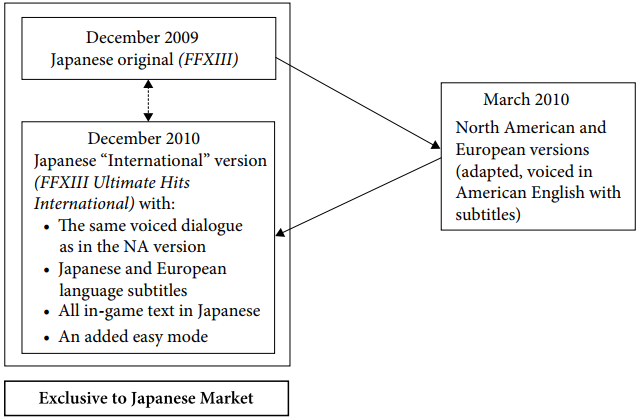- 签证留学 |
- 笔译 |
- 口译
- 求职 |
- 日/韩语 |
- 德语
The above examples demonstrate how cultural differences which arise in the making of the original and its localized version are accommodated in the localization process and how the game company exploits the variability of the software medium to explore experimental approaches in the process of localization. Despite the high stakes involved, the greater degree of freedom to experiment seems to come from the nature of the game business as a dynamic young industry not bound by a particular tradition and, most of all, because of its purpose as a creator of mass entertainment, and this has clearly seeped into innovative new translation approaches.
3. Reverse localization model: International and Final Mix editions
The last category of our examples refers to particular editions of games, specifically prepared for the domestic Japanese market, of certain popular series such as the Final Fantasy (1987-) and Kingdom Hearts (2002). They are known as "International" and "Final Mix" respectively for each series and constitute a reverse localization model (O'Hagan 2012a), where localized NA versions are reintroduced to the Japanese home market by retaining voiced dialogue in English with newly added Japanese subtitles. These editions are intended only for Japanese speakers, with all UI turned back into Japanese. Figure 4 illustrates the flow of the product development, taking the example of FFXIII (2009) and its
International edition FFXIII Ultimate Hits International (2010) which is based on the NA version of FFXIII. This means the International edition can be taken as a version to show to Japanese players the changes made in the NA version.

Figure 4 Original Final Fantasy XIII vs. the re-localized version Final Fantasy XIII
Ultimate Hits International
The key added-value of these editions seems to be the English voiced dialogue, which is preferred to Japanese voice by certain Japanese gamers (O'Hagan 2009c), and any other added features and changes incorporated into the NA locale. While other major Japanese publishers such as Nintendo, Sega, Konami and Capcom also use this model (albeit somewhat more sporadically), Square Enix seems to be the developer/publisher employing it most systematically, thus suggesting the company's exploratory approach to localization.
We acknowledge that the above brief case study based on the example of a global game developer/publisher who undertakes game localization as part of game development cannot be taken as representative of contemporary game localization as a whole. However, we argue that Square Enix's approaches and their underlying philosophy serve to illustrate some of the unique characteristics of translating games and the new perspectives that have emerged in shaping new translation practices. The purpose of the case study was therefore to grapple with new dimensions of translation practice in action as well as to get a sense of direction of where game localization is heading. Insights highlighted by Square Enix's approach to localization might be characterized as: (1) providing an international outlook in developing games and a close link between game development and game localization; (2) recognizing the importance of providing contextual information to translators; (3) assigning a pair of translators to work on the same game and/or use of a third-party editing and rewriting process, and (4) continuous experimentation through localization as part of game development. These observations highlight the company's approach as not treating localized games as lesser derivative products but as new creations which can stand on their own with new added value. What is striking is their liberal leveraging of the localization process in transforming the original product. In their approach the nature of the malleable medium is exploited, which is likely to stem from their expertise as an established game developer and publisher in understanding games as new media entertainment. With these key findings in mind, the next section attempts to identify game localization in terms of translation norms with a focus on translators.
责任编辑:admin
